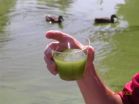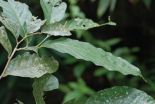(Press-News.org) Researchers at Grand Valley State University's Annis Water Resources Institute are learning more about the impact invasive zebra mussels and native aquatic insect larvae have on the risk of algae blooms in two West Michigan lakes. The results of the research will be published in the journal Oikos.
Postdoctoral researcher Geraldine Nogaro and AWRI director Alan Steinman studied the impact that invasive zebra mussels and native chironomid larvae have on nutrient releases in Muskegon Lake and Bear Lake. While studying the mussels, Nogaro and Steinman noted that filter feeding and excretion activity by invasive mussels stimulated nutrient releases in the water column. The other subject of the research was the impact of native chironomids, which are insect larvae that live in the sediment on the lake bottoms. The researchers found the chironomids burrowed into the sediment, moving water and oxygen into the sediment and increased the levels of nutrients released into the sediment porewater and water column.
"When nutrient levels increase, so does the risk of stimulated algae blooms," Nogaro said. "The blooms are problematic because you can't enjoy the lakes, and because certain blooms of cyanobacteria can release toxins into the water, which impacts fish and other wildlife."
Nogaro also said bacteria growing on decomposing algae blooms can suck up valuable dissolved oxygen in the lake, which can result in large fish kills in the affected areas.
The research reinforces the need to monitor the numbers of mussels in the lake, along with the need to reduce human nutrient input into the ecosystem, including storm runoff that contains nonpoint source pollution.
"These results have management implications, as the effects of invasive mussels on the biogeochemical functioning in the Great Lakes region and elsewhere can alter system bioenergetics and promote harmful algal blooms," Steinman said.
INFORMATION:
To read the complete study, visit http://onlinelibrary.wiley.com/doi/10.1111/j.1600-0706.2013.00978.x/abstract.
GVSU researchers draw link between zebra mussels, risk of algae blooms
Blooms can release toxins, cause fish kills
2014-02-12
ELSE PRESS RELEASES FROM THIS DATE:
Waste from age-old paper industry becomes new source of solid fuel
2014-02-12
In today's search for renewable energy sources, researchers are turning to the hi-tech, from solar and hydrogen fuel cells, and the very low-tech. The latest example of a low-tech alternative comes from an age-old industry: paper. A new study, appearing in ACS' journal Energy & Fuels, reveals a sustainable way to turn the huge amounts of waste from paper production into solid fuel with the added bonus of diverting the sludge from overflowing landfills.
Chinnathan Areeprasert, Peitao Zhao and colleagues note that making paper, from debarking and chipping wood to the final ...
Australian state has higher rate of hypothermia deaths than Sweden
2014-02-12
New research from the University of Adelaide shows that the state of South Australia has a higher rate of deaths from extreme cold compared with the northern European nation of Sweden.
The study, by a team from the University's School of Medical Sciences, analyzed forensic cases of hypothermia deaths from 2006-2011 in both South Australia and Sweden.
The results show that South Australia had a rate of 3.9 deaths for every 100,000 people, compared with Sweden's 3.3 deaths per 100,000. In total, there were 62 fatal cases of hypothermia in South Australia and 296 cases ...
A new species of Oak hidden away in the greenery of Ton Pariwat Wildlife Sanctuary
2014-02-12
An international team of scientists from Xishuangbanna Tropical Botanical Garden (China) and the Forest Herbarium (BKF - Thailand) discovered a new species of Stone Oak in the Ton Pariwat Wildlife Sanctuary in Thailand. This isolated sanctuary is popular for its rich bird- and wildlife such as the Blue-banded Kingfisher and Whitehanded Gibbons, as well for its rare and beautiful flora like Rafflesia's - known to hold some of the largest flowers on earth. The wildlife sanctuary covers a region of low-lying forested mountains and is located in the middle of a fascinating ...
Novel compound keeps Parkinson's symptoms at bay in mice
2014-02-12
Scientists report that they have developed a novel compound that appears to protect mice against developing movement problems associated with Parkinson's disease (PD). The research, which could one day in the future translate into a therapy that could halt the progression of PD and thereby prevent the symptoms of the disease, appears in ACS' Journal of Medicinal Chemistry.
Onyou Hwang, Ki Duk Park and colleagues explain that PD, which affects an estimated 4 million to 10 million people worldwide, is a progressive movement disorder with no known cure. It often starts ...
Paper examines clinical and policy implications of intimate partner violence
2014-02-12
(Boston) --Intimate partner violence (IPV) is a serious public health concern for all, however women who experience IPV are more likely to sustain injury and report adverse health consequences. An expanding body of research suggests that experience of IPV is common in women veterans (WV), particularly those who access Veterans Health Administration (VA) services.
In a review paper currently available online in the Journal of Women's Health, Megan R. Gerber, MD, MPH, assistant professor of medicine, Boston University School of Medicine and Medical Director, Women's Health, ...
New system combines control programs so fleets of robots can collaborate
2014-02-12
Writing a program to control a single autonomous robot navigating an uncertain environment with an erratic communication link is hard enough; write one for multiple robots that may or may not have to work in tandem, depending on the task, is even harder.
As a consequence, engineers designing control programs for "multiagent systems" — whether teams of robots or networks of devices with different functions — have generally restricted themselves to special cases, where reliable information about the environment can be assumed or a relatively simple collaborative task can ...
Bees fight to a stalemate in the battle of the sexes according to new research
2014-02-12
Just like humans, whether or not some genes are switched on in bumblebees is a result of a battle of the sexes between genes inherited from their mother and genes inherited from their father.
Published online today (Wednesday 12 February) in the Royal Society journal, Proceedings of the Royal Society B, a new study from the University of Leicester provides new evidence for the kinship theory of evolution of genomic imprinting in bumblebees.
Each bumblebee worker inherits two copies of every gene – one from their mother and one from their father. For a small number ...
Depressed girls suffer the most
2014-02-12
For the first time researchers have studied the kind of physical pain that troubles adolescents with different mental health problems.
Professor Marit Sæbø Indredavik at the Norwegian University of Science and Technology (NTNU) thinks that everyone working in the health care system, from medical doctors to psychologists, must be more aware of the chronic pain that can plague young people with mental health woes.
From anxiety to ADHD
The researchers gave a questionnaire to 566 teenagers between 13 and 18 years old, all of whom had conditions ranging from ADHD and depression ...
Earwax: A new frontier of human odor information
2014-02-12
PHILADELPHIA (February 12, 2014) – Scientists from the Monell Center have used analytical organic chemistry to identify the presence of odor-producing chemical compounds in human earwax. Further, they found that the amounts of these compounds differ between individuals of East Asian origin and Caucasians. The findings suggest that human earwax, an easily obtained bodily secretion, could be an overlooked source of personal information.
"Our previous research has shown that underarm odors can convey a great deal of information about an individual, including personal identity, ...
New study explains how dense breast tissue drives the early stages of cancer
2014-02-12
Scientists from The University of Manchester working with IBM Research have identified a key biological mechanism that for the first time explains why women with dense breast tissue are at greater risk of developing breast cancer.
The research, published today in the journal Cell Cycle, has important implications for future cancer prevention and treatment.
Women with higher breast density—detected on mammograms—have more compacted breast tissue and are more likely to develop breast cancer, but until now the reasons for this have been unclear.
Manchester scientists, ...
LAST 30 PRESS RELEASES:
The vast majority of US rivers lack any protections from human activities, new research finds
Ultrasound-responsive in situ antigen "nanocatchers" open a new paradigm for personalized tumor immunotherapy
Environmental “superbugs” in our rivers and soils: new one health review warns of growing antimicrobial resistance crisis
Triple threat in greenhouse farming: how heavy metals, microplastics, and antibiotic resistance genes unite to challenge sustainable food production
Earthworms turn manure into a powerful tool against antibiotic resistance
AI turns water into an early warning network for hidden biological pollutants
Hidden hotspots on “green” plastics: biodegradable and conventional plastics shape very different antibiotic resistance risks in river microbiomes
Engineered biochar enzyme system clears toxic phenolic acids and restores pepper seed germination in continuous cropping soils
Retail therapy fail? Online shopping linked to stress, says study
How well-meaning allies can increase stress for marginalized people
Commercially viable biomanufacturing: designer yeast turns sugar into lucrative chemical 3-HP
Control valve discovered in gut’s plumbing system
George Mason University leads phase 2 clinical trial for pill to help maintain weight loss after GLP-1s
Hop to it: research from Shedd Aquarium tracks conch movement to set new conservation guidance
Weight loss drugs and bariatric surgery improve the body’s fat ‘balance:’ study
The Age of Fishes began with mass death
TB harnesses part of immune defense system to cause infection
Important new source of oxidation in the atmosphere found
A tug-of-war explains a decades-old question about how bacteria swim
Strengthened immune defense against cancer
Engineering the development of the pancreas
The Journal of Nuclear Medicine ahead-of-print tip sheet: Jan. 9, 2026
Mount Sinai researchers help create largest immune cell atlas of bone marrow in multiple myeloma patients
Why it is so hard to get started on an unpleasant task: Scientists identify a “motivation brake”
Body composition changes after bariatric surgery or treatment with GLP-1 receptor agonists
Targeted regulation of abortion providers laws and pregnancies conceived through fertility treatment
Press registration is now open for the 2026 ACMG Annual Clinical Genetics Meeting
Understanding sex-based differences and the role of bone morphogenetic protein signaling in Alzheimer’s disease
Breakthrough in thin-film electrolytes pushes solid oxide fuel cells forward
Clues from the past reveal the West Antarctic Ice Sheet’s vulnerability to warming
[Press-News.org] GVSU researchers draw link between zebra mussels, risk of algae bloomsBlooms can release toxins, cause fish kills


